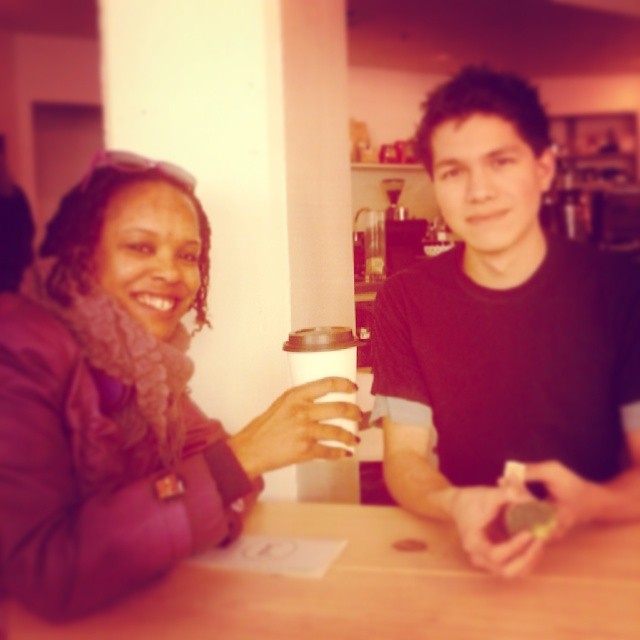Image above: On the left, my friend Purpelle Tramble, the filmmaker. On the right, some guy with short hair…
Two unrelated interactions with different late-night 7 riders featuring almost exactly the same import, and not one I was expecting:
Two men are up front, street guys. Both about thirty, lanky men in shirts so huge another culture would call them dresses, and correspondingly massive denim jeans of a murky grey color. I’m reminded of male grouse which puff out their feathers when trying to attract a mate, making every effort to look larger than life. The first fellow, of mixed descent, has a three-day growth about his face and a light fuzz obscuring his bald pate. The second man, a slightly younger caucasian gent, had asked upon boarding if I recognized him. I did. “You look good now, man,” I’d said. He used to stumble aboard in terrible shape, dressed in holed tatters and clearly somewhere far away mentally… but now his hair has grown back, and he’s showered and clean, on kilter.
The first man did the talking. Smiling in the dark: “you get a haircut?”
“Yup, it was gettin’ a lil’ crazy! Startin’ to turn into a wild animal!”
“Ha!”
This is my haircut strategy. It’s quite simple. Get it cut a little shorter than you’d like, for the sake of variety and so you don’t have to go as often, and let it lie fallow while it grows into this nice mixture of astronaut/soccer player messy. Then the curls start to come out. Then it starts doing the Frodo Thing. After that it starts getting into these weird Wolverine-Tarzan-Javier Bardem stages that don’t make any sense. Various friends and acquaintances have different ideas of when along this sequence I need a haircut, but in my opinion, a trip to the barber is imminent right around the high point of the Frodo stage. With my hair just cut, I always feel surprised upon looking in the mirror– my mental self-image has longer hair in those moments than my real self does, as I look at the strange bespectacled person across from me, looking not like an artist but some young guy in advertising from ’50s Northern California.
I said, “but I think now I look a little bit square, you know what I mean?”
I expected him to agree, but instead he replied with, “dude, square’s tight. Square’s the new cool. I wish I was square, dogg.”
“What? You serious?”
“You know, iss funny. As you get older, it ain’t cool to be cool no more. Be the shit and be no shit. Iss all about bein’ square. With it.”
“I wanna be right in the middle somewhere.”
“Yeah.”
Okay. A somewhat unexpected opinion from one street guy. Not the most surprising thing. But an hour later, Jason (the very same, from the post below this one) and a ladyfriend stepped in.
Jason grinned as he said, “gotchur haircut!”
“Yeah, it was gettin’ outta hand! They said I was turnin’ into a wild animal!”
“Iss cool!”
“But now I feel a lil’ bit square!”
His lady cried, “jigga-what?”
Jason: “Nate, you are all the way there.”
“What?”
“Das why you so cool!” Jason cried, as his friend explained her outburst:
“Yeah, iss cool to be square! Square’s da new thing!”
There was a point in Eminem’s musical career where he strayed from the typical hip-hop clothing ensemble and began showing up to functions wearing a sharp but fairly modest three-piece suit with wire-frame glasses and no jewelry. Why?
I don’t know. Mr. Mathers was always an interesting sort (he had two platinum albums in 2000 and was still driving a Camry!). But there are others, too; the late Bowie look comes to mind. Maybe the definitions of cool are crumbling and shifting, as I’ve written about before.* Maybe there comes an age when you don’t have to set yourself apart so obviously in order to claim your individuality. Or maybe these folks on my bus tonight just really like short hair.
—
*Here, here and here. The underpinning for these writings stems largely from Ted Gioia’s The Birth (and Death) of the Cool, which explores the factors which caused coolness to come into being during the postwar years, and why Gioia feels the concept is on its way out now. Highly recommended.
Nathan Vass is an artist, filmmaker, photographer, and author by day, and a Metro bus driver by night, where his community-building work has been showcased on TED, NPR, The Seattle Times, KING 5 and landed him a spot on Seattle Magazine’s 2018 list of the 35 Most Influential People in Seattle. He has shown in over forty photography shows is also the director of nine films, six of which have shown at festivals, and one of which premiered at Henry Art Gallery. His book, The Lines That Make Us, is a Seattle bestseller and 2019 WA State Book Awards finalist.


